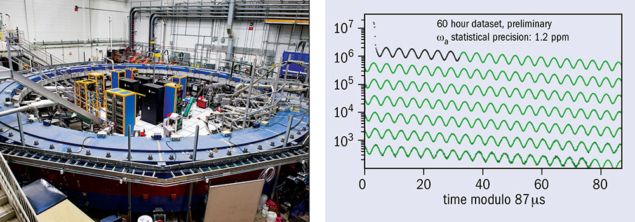
A new experiment at Fermilab in the US, designed to make the most precise measurement of the muon’s magnetic moment, has completed its first physics data-taking campaign, showing promising results. Experiment E989 is a reincarnation of the muon g-2 experiment at Brookhaven National Laboratory (BNL), which ran in the late 1990s and early 2000s and found the muon’s anomalous magnetic moment, aμ, to be approximately 3.5 sigma above the Standard Model prediction. The Fermilab experiment aims to resolve this long-standing discrepancy, revealing whether it is due to a statistical fluctuation or to the existence of new particles that are influencing the muon’s behaviour.
The international E989 collaboration hopes to measure aμ to a final precision of 140 parts per billion, improving on the BNL result by a factor of four. Following months of commissioning efforts beginning last autumn, the experiment started taking data in February. Its net accumulated dataset is already almost twice that obtained by BNL, although much of the initial run involved varying the operating conditions to optimise data collection and explore systematics.
The principle behind the Fermilab and BNL experiments is the same: muons start with their spins aligned with their direction of motion, but as they journey around the storage ring they precess at a frequency proportional to the magnetic field and to the value of aμ. At experiment E989, muons are vertically focused in the ring via a system of electric quadrupoles, and the precession frequency is determined using a set of 24 electromagnetic calorimeters located along the inner circumference of the ring. The new experiment reuses the 1.45 T superconducting storage ring from BNL, which was shipped from Long Island to Chicago in 2015 and has since been rebuilt, its magnetic field now shimmed to a uniformity that exceeds BNL’s by a factor of three. Nearly all of the other aspects of the experiment are new.
The Fermilab Muon Campus – which will also serve the Muon-to-Electron Conversion experiment in the future – provides an intense polarised muon beam that is devoid of the pion contamination that challenged the BNL measurement. Bunches of muons are injected into the storage ring and then “kicked” during their first rotation around the ring. “This is one of the most challenging aspects and one that the collaboration continues to develop because the kick quality affects the net storage efficiency and the momentum distribution,” explains E989 member and former co-spokesperson David Hertzog.
A representative sample from a 60-hour-long dataset (see figure) demonstrates precession-frequency modulation on top of an exponentially decaying muon population. The collaboration is now evaluating data samples and developing different and independent approaches to extract the precession frequency and minimise systematic uncertainties. E989 researchers are also working to evaluate the average magnetic field and important beam-dynamics parameters.
In parallel, theorists are working hard on Standard Model calculations to reduce the uncertainties in the predicted value of aμ – in particular concerning hadronic corrections, which are the most challenging to evaluate due to the complexities of quantum chromodynamics (QCD). In June, Alexander Keshavarzi from the University of Liverpool, UK, and colleagues used electron–positron collision data to reevaluate the hadronic contribution to aμ, leading to the highest precision prediction so far. The following month, Thomas Blum of the University of Connecticut, US, and co-workers in the RBC and UKQCD collaborations reported a complete first-principles calculation of the leading-order hadronic contribution to aμ from lattice QCD and quantum electrodynamics, showing improved precision.
Physicists will have to wait a bit longer for E989 to release a first measurement of aμ, however. “Until we can closely examine the data quality – both precession data from detectors and field data from NMR probes – we are unable to predict the timetable,” says Hertzog. “Our aim is sometime in 2019, but we will unblind only after we are certain that the analysis is complete – so stay tuned.”
Further reading
T Blum et al. 2018 Phys. Rev. Lett. 121 022003.
A Keshavarzi et al. 2018 Phys. Rev. D 97 114025.








